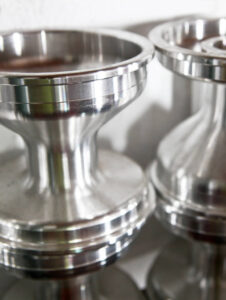Part machining is a lengthy process, even with CNC machining, usually involving multiple processes. In the process of the process, there is a concept of “machining allowance”.
Maybe you haven’t been exposed to this concept before, this article will help you understand it!
What is machining allowance?
During the machining process, the excess metal on the surface to be machined on the workpiece is removed by machining to obtain the machined surface required by the design. The thickness of the metal layer reserved (to be removed) on the surface of the part is called the machining allowance. It is divided into process allowance and total machining allowance.
Process margin
The process margin refers to the thickness of the metal layer that is removed from a surface in one process, that is, the difference between the process dimensions of two adjacent processes.
Due to the tolerance of the process size, in fact, the allowance of the same batch of workpieces is changed, so the allowance can be divided into basic allowance (or nominal allowance, nominal allowance), maximum allowance and minimum allowance. Whether the processing surface is symmetrical or not, the process allowance can also be divided into unilateral allowance and bilateral allowance. Process dimensions and tolerances are generally marked according to the “in-body principle”. For contained dimensions (such as shaft diameter), the nominal size is the maximum process dimension, and the upper limit deviation is 0; for contained dimensions (such as aperture, groove width), Its nominal size is the minimum process size, and the lower limit deviation is 0. For the process size and blank size of the hole distance, it is generally marked according to the symmetrical deviation.
Total machining allowance
The total processing allowance refers to the total thickness of the metal layer cut off on a certain processing surface during the process from the blank to the finished product, that is, the difference between the blank size and the design size of the part drawing 2, which is also equal to the sum of the working allowance of the surface .
Why do we need machining allowance?
Eliminate processing deviation
First of all, the simplest and most direct reason is to eliminate processing deviation.
The processing of a part often requires multiple processes, and due to the current technical limitations, usually there will be some dimensional deviation problems after the part completes the previous process. Retaining the machining allowance can help us eliminate various errors left by the previous process in the subsequent process.
Improved accuracy and surface roughness
After the parts complete the previous process, in addition to the problem of dimensional deviation, some surface problems will remain. If there is a machining allowance, it can help eliminate the processing errors and external defects such as burrs, pores, sand interlayers, oxide skins, decarburization layers, and external cracks left on the outside of the parts in the previous process.
The size of the machining allowance directly affects the machining quality and production efficiency of the parts. Excessive machining allowance will not only increase the labor of mechanical processing and reduce production efficiency, but also increase the consumption of materials, tools and electricity, and increase costs. However, the machining allowance is too small, and it cannot guarantee the elimination of and surface defects, and even produces waste products. Therefore, the machining allowance must be reasonably determined. We usually use three methods to determine the machining allowance:
(1) Look-up table method: According to the machining allowance data provided by the relevant manual, combined with the actual production situation of the factory, the machining allowance is determined after correction. This is a method widely used by factories.
(2) Experience estimation method: determine the machining allowance according to the experience accumulated by the craftsmen themselves. Generally, in order to prevent waste products from being too small, the estimated margin is always too large. This method is often used in single-piece, small-batch production.
(3) Analysis and calculation method: According to the theoretical formula and certain test materials, analyze and calculate the factors affecting the machining allowance to determine the machining allowance. This method is more reasonable, but it requires comprehensive and reliable test data, and the calculation is more complicated. It is generally only used in factories with very expensive materials or a few large-scale and mass-produced factories.
Hope the above content is helpful to you.




